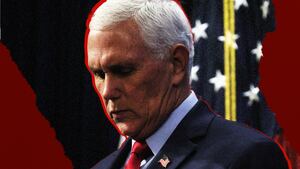It’s time once again for the “Mardi Gras for the Right,” also known as the Conservative Political Action Conference (CPAC). The annual gathering has long been a riotous affair, but the bacchanalian revelry once belied a buttoned-down conservative class that ran the event.
These days, they let their freak flag fly. And no, I’m not talking about dubious yarns of after-hours debauchery—though I am old enough to remember Steve Stockman’s hot tub party (no, I wasn’t there). I’m talking instead about political statements that will be uttered on stage by credentialed speakers or on camera by attention-starved activists and attendees. I mean, the event just kicked off Thursday, and already, a video with a self-described “Jan. 6 political prisoner” is garnering buzz.
Those small potatoes will quickly be forgotten. Every CPAC has a narrative, but what will this year be? Attendance could be down. That’d be embarrassing. Big names like Gov. Ron DeSantis are skipping this year’s event. Could it be that CPAC isn’t as relevant as it used to be? What is more, this year’s meeting is taking place on the heels of allegations that the event’s organizer, Matt Schlapp, groped a Herschel Walker campaign aide.
Any of these stories could be the big one. But my money’s on another option: The Trumpification of CPAC.
Kellyanne Conway envisioned this future back in 2017, when she dubbed the event “TPAC.” Of course, back then, Trump was a newly-minted president—not a perpetual drag on the party’s electoral prospects. The fact that CPAC is doubling down on Trumpism now tells you all you need to know about the direction of the movement and the party, not to mention their penchant for lost causes (one of the other big speakers this year will be election-denier Kari Lake).
This is not how it was supposed to go. Trust me, I know. Back in 2012, I was CPAC’s “Blogger of the Year.” I know what you’re thinking: What’s a blogger? It doesn’t matter. The point is that a mere eleven years ago, I wasn’t just the kind of person that CPAC could tolerate, I was feted.
What a long, strange trip it’s been.
CPAC and I were born the same year. In 1974, Ronald Reagan spoke at the very first CPAC gathering. He began by introducing three Vietnam P.O.W.s. One of them was, you guessed it, John McCain. (In 2019, the ghost of John McCain was attacked from the stage of CPAC.)
But even for those who aren’t huge McCain fans, the contrast is clear. My friend Craig Shirley, the acclaimed conservative historian, was recently quoted in The New York Times lamenting the conference’s decline since the ‘70s. “It’s more of like a boat show,” Shirley said.
I can think of other words besides “boat.” Ship might be closer.
CPAC was serious and wonky back in the Reagan era, but that started to change long before I attended the first of my many CPACs in 2000. By then, the hall was bustling with young college students who had presumably been bussed in by organizers and/or campaigns vying to win the presidential straw poll.
To be sure, there have always been eccentric attendees. A tongue-in-cheek essay I wrote for the Daily Caller in 2012 lamented the “gadflies” and “time burglars” who populate these events.
But there used to be a lot of intellectually stimulating things to do and see.
For example, CPAC long featured an annual conversation between legendary journalists Sam Donaldson and Bob Novak. There were other speakers like P.J. O’Rourke, George Will, and Charles Krauthammer, who addressed the crowd.
The modern equivalent is, apparently, Mike Lindell, Marjorie Taylor Greene, and Kimberly Guilfoyle.
To be sure, CPAC speakers have long existed on a spectrum, somewhere between William F. Buckley and P.T. Barnum. But in the last dozen years, or so (coinciding, it seems, with the election of Barack Obama—and then exploding with Trump’s election), it began skewing very heavily toward the Barnum end.
There are numerous warning signs along the way, but let me remind you of just a few:
In 2009, my friend and former boss Tucker Carlson was briefly booed at CPAC for praising The New York Times for accuracy.
In 2011, CPAC invited Donald Trump—who was just a crazy celebrity touting “birtherism”—to give a speech.
In what might be considered his political coming out (as a conservative) party, Trump “was by far the best-received speaker and the audience lapped up his act,” reported Maggie Haberman.
That same year, libertarian ex Rep. Ron Paul won the CPAC straw poll.
None of these things, in and of themselves, were terribly surprising or noteworthy (the straw poll was always manipulated by campaigns, which is to say the results were far from organic or even scientific). Collectively, however, these developments now strike me as telling. They were harbingers of things to come.
My conclusion is this: If you want to know what the conservative movement will look like in five years, look at what today’s CPAC hall is like.
That is a scary thought, because if that analysis turns out to be true, Donald Trump is the GOP’s future. After all, he’s their celebrated hero. And with Ron DeSantis presumably sitting this CPAC out, he’s the only game in town.









